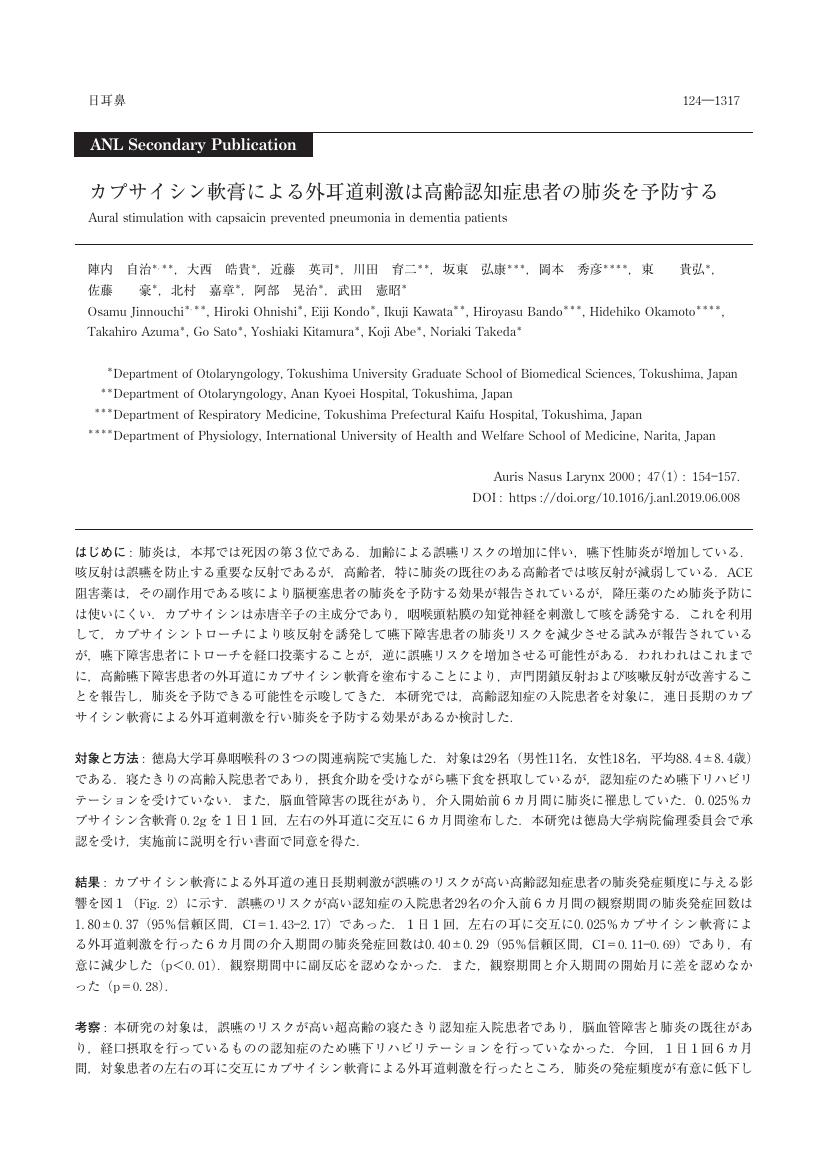6 0 0 0 OA 第1回ガスタービンに関する座談會記録 : 内燃機関部門主催
- 著者
- 甘利 〓一 磯貝 誠 稲生 光吉 大塚 誠之 大塚 芳郎 大塚 新太郎 河田 三治 後藤 清太郎 佐藤 豪 佐藤 忠雄 柴田 万壽太郎 栖原 豊太郎 須之部 量寛 棚沢 泰 種子島 時休 玉木 福宜 土光 敏夫 中西 不二夫 永野 治 長尾 不二夫 西脇 仁一 沼知 福三郎 林 貞助 久野 五十男 福山 勉 藤井 澄二 堀越 博 松永 陽之助 村井 等 森 糾明 矢木 栄 山内 正男 吉水 直一
- 出版者
- 一般社団法人 日本機械学会
- 雑誌
- 日本機械学會論文集 (ISSN:00290270)
- 巻号頁・発行日
- vol.17, no.58, pp.151-174, 1951-01-30 (Released:2008-03-28)
5 0 0 0 OA 平衡訓練/前庭リハビリテーションの基準 ―2021年改訂―
- 著者
- 平衡訓練の基準の改訂ワーキンググループ 担当理事 : 北原 糺 肥塚 泉 堀井 新 委員長 : 伏木 宏彰 委員 : 山中 敏彰 五島 史行 佐藤 豪
- 出版者
- 一般社団法人 日本めまい平衡医学会
- 雑誌
- Equilibrium Research (ISSN:03855716)
- 巻号頁・発行日
- vol.80, no.6, pp.591-599, 2021-12-31 (Released:2022-02-16)
- 参考文献数
- 50
- 被引用文献数
- 4
4 0 0 0 OA 咀嚼によりめまいが誘発されたCosten症候群症例
- 著者
- 関根 和教 今井 貴夫 立花 文寿 松田 和徳 佐藤 豪 武田 憲昭
- 出版者
- 一般社団法人 日本めまい平衡医学会
- 雑誌
- Equilibrium Research (ISSN:03855716)
- 巻号頁・発行日
- vol.69, no.1, pp.47-51, 2010 (Released:2010-04-01)
- 参考文献数
- 15
We report a case of Costen's syndrome that showed chewing-induced nystagmus and vertigo. A 31-year-old woman visited our hospital complaining of chewing-induced vertigo 5 days after dental therapy. During chewing a stick of gum, she complained of vertigo and showed nystagmus beating to the right, the direction of which changed to the left thereafter. No spontaneous and positional nystagmus or any abnormalities in the neurological examination could, however, be found. The chewing-induced nystagmus and vertigo gradually disappeared within 2 weeks. Costen's syndrome is associated with various symptoms due to temporomandibular dysfunction. In the case, it is suggested that malinterdigitation after dental therapy caused temporomandibular dysfunction, resulting in the chewing-induced nystagmus, therefore, Costen's syndrome was diagnosed.Eustachian tube hypothesis, Tensor tympani hypothesis and otomandibular ligament hypothesis that accounted for temporomandibular dysfunction-induced aural symptoms in patient with Costen's syndrome had been proposed, but recently were withdrew. On the other hand, it is reported that reciprocal connections between trigeminal and vestibular nuclei. The trigeminal somatosensory input associated with temporomandibular dysfunction after dental therapy may cause chewing-induced nystagmus via the trigemino-vestibular connection in the brainstem in the case.
4 0 0 0 OA タイプA行動パターンとストレス反応
- 著者
- 佐藤 豪
- 出版者
- 日本行動医学会
- 雑誌
- 行動医学研究 (ISSN:13416790)
- 巻号頁・発行日
- vol.3, no.1, pp.8-15, 1996 (Released:2014-07-03)
- 参考文献数
- 39
タイプA行動パターンは、冠動脈疾患の発症の原因となる行動様式として、近年広く知られるようになった。本論文ではタイプA行動パターンと冠動脈疾患を結びつける要因としてストレスとそれに対する心理・生理的反応との関連について検討することを目的とする。タイプA者は自己価値が様々な外的要因によって変動しやすいものと感じているために、絶えず自尊心についての危機感を持っている。またタイプA行動パターンの形成には信頼性の乏しい対人関係や、幼少期における両親の達成努力に重きを置いた養育態度が寄与しているものと考えられる。タイプA者はタイプB者よりも自らが直面したストレスを過大に評価し、より危機的状況ととらえやすい傾向を持ち、そのためにストレスに対して能動的対処を行おうとすることが示されている。このような対処行動中にはタイプA者はタイプB者に比べて交感神経系の興奮の増大、内分泌学的反応性の昂進、また心理的ストレス反応の増大を示すことが明らかとなっている。交感神経系の興奮の持続は、循環器系、内分泌学的な機能の異常を引き起こし、冠動脈疾患の発症に寄与しているものと考えられる。またタイプA行動パターンが末梢のβアドレナリン系の反応抑制によって減少するという研究から、末梢の反応性もタイプA行動パターンの形成に寄与している可能性が示されてきた。さらに中枢性のドーパミン作動系機能とJenkins Activity Surveyの検査成績からタイプA行動パターンにはアレキシサイミア的特徴があることが示唆された。さらにドーパミン作動系機能の歪みと幼少期における両親との分離体験の関連性を示す研究からタイプAの形成過程には幼少期の心理的体験が関与しており、それがドーパミン作動系機能などの心理・神経・内分泌機能の歪みを起こし、タイプAの形成に関与する可能性を示唆した。本論文では、タイプA行動パターンの性質の解明のためには心理・神経・内分泌学的研究と、心理・社会的研究の両方が必要であることを示した。
3 0 0 0 OA 自己志向的完全主義と防衛機制および不安との関連
- 著者
- 中川 明仁 佐藤 豪
- 出版者
- 一般社団法人 日本健康心理学会
- 雑誌
- 健康心理学研究 (ISSN:09173323)
- 巻号頁・発行日
- vol.24, no.2, pp.1-8, 2012-03-10 (Released:2013-09-06)
- 参考文献数
- 34
- 被引用文献数
- 1
Relationships between multidimensional self-oriented perfectionism, defense mechanisms and anxiety were investigated. Participants were university students (n = 169: 68 men and 101 women). They completed the following questionnaires: Multidimensional Self-oriented Perfectionism Scale (MSPS), Defense Style Questionnaire 42 (DSQ42) and State Trait Anxiety Inventory (STAI). Path analysis indicated that Personal Standards positively affected mature defense mechanisms; and moreover, mature defense mechanisms had negative effect on trait anxiety. Moreover, Concern over Mistakes had a positive effect on immature defense mechanisms, and furthermore, immature defense mechanisms had positive effect on trait anxiety.
3 0 0 0 OA 自己愛人格傾向についての素因–ストレスモデルによる検討
- 著者
- 小西 瑞穂 山田 尚登 佐藤 豪
- 出版者
- 日本パーソナリティ心理学会
- 雑誌
- パーソナリティ研究 (ISSN:13488406)
- 巻号頁・発行日
- vol.17, no.1, pp.29-38, 2008-09-01 (Released:2008-10-24)
- 参考文献数
- 29
- 被引用文献数
- 9 2
自己愛人格傾向がストレスに脆弱な素因であるかを検討するために,大学生174名(男性72名,女性102名)を対象として縦断的調査を行った。自己愛人格傾向の高い者は最近1ヶ月以内のストレッサー経験量が多いと精神的健康が低下するという仮説を立て,精神的健康のネガティブな側面をストレス反応,ポジティブな側面をハッピネスとして測定した。階層的重回帰分析の結果,自己愛人格傾向の高い者がストレスイベントを多く経験した場合,男性では抑うつ反応および自律神経系活動性亢進反応,女性では身体的疲労感が増加し,一方ストレスの少ない状況ではこれらのストレス反応が自己愛人格傾向の低い者や平均的な者に比べて最も少なかった。つまり,自己愛人格傾向には個人の精神的健康を部分的に支える働きがあるが,それはストレスの少ない状況に限定されたものであり,ストレスの多い状況ではストレス反応を生起しやすい,ストレスに脆弱な素因と考えられる。
2 0 0 0 OA カプサイシン軟膏による外耳道刺激は高齢認知症患者の肺炎を予防する
- 著者
- 陣内 自治 大西 皓貴 近藤 英司 川田 育二 坂東 弘康 岡本 秀彦 東 貴弘 佐藤 豪 北村 嘉章 阿部 晃治 武田 憲昭
- 出版者
- 一般社団法人 日本耳鼻咽喉科頭頸部外科学会
- 雑誌
- 日本耳鼻咽喉科頭頸部外科学会会報 (ISSN:24365793)
- 巻号頁・発行日
- vol.124, no.9, pp.1317-1318, 2021-09-20 (Released:2021-10-01)
- 著者
- 地理ゼミ生 三浦 駿平 川畑 維吹 斎藤 優史 前園 太一 松田 信太朗 小島 隼 熊谷 暦太 高木 大成 高橋 航大 星 穣司 安藤 希 大内 星李 亀谷 伶央 佐藤 豪 浅川 俊夫
- 出版者
- 東北福祉大学教職課程支援室
- 雑誌
- 教職研究
- 巻号頁・発行日
- vol.2019, pp.45-61, 2020-03-31
「地誌」授業で、2016年度から世界の10か国及び日本の10都県の位置について、受講生がどの程度認識しているか調査してきた結果を、①高校での地理科目履修状況との関係、②正答率の経年変化、③誤答の傾向に分けて分析・考察した。①では、世界の地理認識について正答率が低い国で地理科目履修者の正答率が未履修者を上回る傾向がみられる。②では、変化パターンから、調査した10か国は、正答率が上昇傾向、低下傾向、調査年により上昇・低下、ほぼ一定の4グループに、10都県は、上昇傾向、調査年により上昇・低下、ほぼ一定の3グループに分けられる。③では、世界の地理認識について、正答の国に近接またはその国が属する地域の国を誤答、名称の似た地域・国を誤答、全く別の地域の国を誤答という三つの誤答パターンが、日本の地理認識については、隣接または正答の県が含まれる地方の県を誤答、全く別地方の県を誤答という二つの誤答パターンが認められる。
2 0 0 0 IR 心身症患者のエゴグラムによる心理特徴の検討
- 著者
- 高橋 恵子 奥瀬 哲 八代 信義 佐藤 豪 岩渕 次郎
- 出版者
- 旭川医科大学
- 雑誌
- 旭川医科大学紀要. 一般教育 (ISSN:03878090)
- 巻号頁・発行日
- vol.18, pp.11-26, 1997-03
出版社版1)尺度得点の因子分析からACに関連した自我状態で,神経性過食症は感情抑制とそれによる慢性的な陰性感情の蓄積傾向を顕著に示し,不適応感が強く,不安-抑鬱気分を伴った過敏な対人関係,過剰適応傾向が示された. 2)消化性潰瘍は,不安-抑鬱気分などの心理状態についての自覚が乏しい傾向にあった. 3)過換気症候群や神経性嘔吐の患者群は,理性的,知的に自己を統制し,外界に対して望ましい社会性を示そうとする意識が高かった.一方,不安感などの内面的問題に関しては防衛的傾向にあり,抑圧的で緊張の強い適応様式が窺われた. 4)また過敏性腸症候群の患者のエゴグラムは特にきわだった傾向は見出されなかった
2 0 0 0 OA 震災時における都心部非定住被災者の受療行動予測・対応策に関する研究
本研究の目的は、首都直下地震が発生した際に,被災者の医療を受け持つフロントライン医療サービス拠点の規模を検討するための、新宿駅周辺の非住宅の死傷者数の推定である。調査は新宿駅の東西口周辺の歩行者数を把握するものである。その結果,西口側には4-6,000人,東口側には2-10,000人の歩行者数が確認された。これを元に負傷者数を推計すると、西口側の負傷者数は一日のどの時間帯でも80人程度と安定しているが、東口の場合,午前中は35人、午後は85人,夕方は100人と変動が大きい。同様に,建物内の負傷者数も推計した。更に, 2011年3月11日東日本地震当日の行動について,アンケート調査を実施した。それらの結果から、新宿西口周辺に13箇所のフロントライン災害医療拠点を設ける場合,各所で67人程度の負傷者の治療を行うことが推定され,負傷者の分布に基づいて、東に8箇所,西に5箇所を配置することになる。
1 0 0 0 OA 両側性前庭障害に対する TPAD による感覚代行を用いた平衡訓練
- 著者
- 佐藤 豪
- 出版者
- 一般社団法人 日本めまい平衡医学会
- 雑誌
- Equilibrium Research (ISSN:03855716)
- 巻号頁・発行日
- vol.80, no.3, pp.210-215, 2021-06-30 (Released:2021-08-04)
- 参考文献数
- 19
- 被引用文献数
- 2
Bilateral vestibulopathy is characterized by bilateral functional impairment of the peripheral vestibular system. The usual symptoms are persistent unsteadiness and oscillopsia during head and body movements. It has been reported that sensory substitution therapy, that is, vestibular rehabilitation using a sensory substitution device, which transmits other sensory information to a stimulator as a substitute for defective vestibular information, might be effective in patients with bilateral and unilateral vestibulopathy. Recently, we developed a new wearable device, TPAD (tilt perception adjustment device), that transmits vibratory input containing head-tilt information to the mandible as a substitute for defective vestibular information. We assessed the patient using the dizziness handicaps inventory (DHI), gait analysis, and visual/somatosensory dependence of postural control in the patients with unilateral vestibulopathy. Three months after therapy in patients with unilateral vestibulopathy, the DHI and walking speed improved even when the subjects were not wearing the TPAD. Moreover, the index of the visual dependence of posture control that was evaluated by posturography with/without foam rubber in the eyes open or closed condition decreased. The findings suggested that the sensory vibratory substitution with a TPAD for defective vestibular information induced brain plasticity related to sensory re-weighting to reduce the visual dependence of posture control, resulting in the improvement of dizziness and imbalance even while not wearing the TPAD in vestibulopathy patients. We then investigated the effects of sensory substitution therapy using a TPAD in patients with bilateral vestibulopathy and normal subjects. Three months after sensory substitution therapy in patients with bilateral vestibulopathy, the DHI and area with eyes closed measured by posturography improved even when the subjects did not wear a TPAD. However, the gait parameters improved only under the condition of wearing a TPAD. These findings suggest that sensory vibratory substitution with a TPAD might serve as temporary replacement for defective vestibular information in patients with bilateral vestibulopathy. Moreover, wearing of the TPAD improved posture control under the eyes-closed condition with foam rubber measured by posturography in normal subjects. TPAD might be applicable as a wearable device for improving posture control, not only in patients with bilateral vestibulopathy, but also in those with presbyvestibulopathy.
1 0 0 0 OA 姿勢制御に対する視覚依存から体性感覚依存へ重み付けを再調整する平衡訓練法の開発
本研究の目的は、振動覚を用いた感覚代行技術により、視覚依存性と体性感覚依存性の重み付けを変化させることにより、安定した姿勢制御を獲得できる新しい前庭リハビリテーションを開発することである。本研究により、頭部の傾斜情報を下顎の振動覚としてフィードバックできるウェアラブルデバイスを開発し、失われた前庭情報を振動覚として感覚代行することが可能となった。健常人に対しては、装用により視覚依存性と体性感覚依存性の低下し、一側前庭障害患者に対しては、視覚依存性と体性感覚依存性が変化することで歩行機能が改善し、めまいのQOLも改善した。両側前庭障害患者に対しては、歩行に対する装用効果を認めた。
- 著者
- 飯塚 まり 佐藤 豪 中川 吉晴
- 出版者
- 日本トランスパーソナル心理学/精神医学会
- 雑誌
- トランスパーソナル心理学/精神医学 (ISSN:13454501)
- 巻号頁・発行日
- vol.18, no.1, pp.1-10, 2019 (Released:2022-10-28)
- 著者
- 馬場 天信 佐藤 豪 齋藤 瞳 木村 穣 中川 明仁
- 出版者
- 一般社団法人 日本心身医学会
- 雑誌
- 心身医学 (ISSN:03850307)
- 巻号頁・発行日
- vol.52, no.10, pp.937-944, 2012-10-01 (Released:2017-08-01)
- 参考文献数
- 21
肥満治療において臨床心理士を加えたチーム医療システムは効果的である.また,パーソナリティ尺度は,肥満症患者の置かれている心理社会的状況を理解するツールとして,患者と治療スタッフ双方に有益な情報を提供する.パーソナリティと肥満に関する研究報告は近年増加しているが,日本人の肥満症患者に関する報告は数少ない.本研究ではNEO-PI-R, TEG II, TAS-20を用いて,肥満症患者と一般成人におけるパーソナリティの違いを検討したところ統計的差異は認めらなかった.次に,肥満度別によるパーソナリティの違いについて分散分析を用いて検討したところ,BMI35以上の肥満症患者は神経症傾向(特に不安と抑うつ)が高く,感情同定困難という特徴が認められた。以上の結果は,肥満度の高い肥満症患者に対する介入にはパーソナリティの査定が有効であることを示唆している.
1 0 0 0 OA 大学生の自己愛人格傾向と自我状態との関連
- 著者
- 小西 瑞穂 山田 尚登 佐藤 豪
- 出版者
- 滋賀医科大学雑誌刊行会
- 雑誌
- 滋賀医科大学雑誌
- 巻号頁・発行日
- vol.21, no.1, pp.4-8, 2008
In recent years, narcissistic personality is seen as a trait especially among young people. This personality traithas an ambivalent feature that unsettled self-valuation easily influenced by others, while it is energetic and aself-centered, being filled with confidence. In this research, we examined the relationship between narcissistic personalityand five ego states -critical parent (CP), nurturing parent (NP), adult (A), free child (FC), adapted child (AC), using theEgogram. Moreover, in order to consider the relevance to narcissistic personality and mental health, we measureddepression as a negative side of mental health and subjective happiness as a positive side. The results showed that CP, Aand FC increased narcissistic personality. CP reflected the authority, dominant and exclusive characteristics. A reflectedcool and not confused attitude by the others' feeling. FC reflected the less consideration for others and selfish behavior.From these results, this study confirmed the features of the narcissistic personality more clearly. Finally, the subjectswith high narcissistic personality had lower depression and higher subjective happiness than the subjects with lownarcissistic personality. The narcissistic personality was supposed to be the factor to enhance the mental health.
1 0 0 0 OA P-1202 自己愛人格傾向と自我状態との関連について
- 著者
- 小西 瑞穂 佐藤 豪 橋本 宰
- 出版者
- 日本パーソナリティ心理学会
- 雑誌
- 日本パーソナリティ心理学会発表論文集 15 (ISSN:24332992)
- 巻号頁・発行日
- pp.20-21, 2006 (Released:2017-09-01)
- 著者
- 佐藤 豪 伊藤 琢也 庄司 洋子 三浦 康男 見上 彪 伊藤 美佳子 倉根 一郎 SAMARA Samir I. CARVALHO Adolorata A. B. NOCITI Darci P. ITO Fumio H. 酒井 健夫
- 出版者
- 社団法人日本獣医学会
- 雑誌
- The journal of veterinary medical science (ISSN:09167250)
- 巻号頁・発行日
- vol.66, no.7, pp.747-753, s-ix-s-x, 2004-07-25
- 被引用文献数
- 2 37
ブラジルで採取された狂犬病ウイルス株14検体を用いて,病原性および抗原性状に関連するG蛋白遺伝子およびG-L間領域(シュートジーン)について遺伝子および系統学的解析を行った.分離株は,ヌクレオ(N)蛋白の解析によって犬型狂犬病ウイルス(DRRV)または吸血コウモリ型狂犬病ウイルス(VRRV)の2系統に分類された.これらのG蛋白コード領域とジュードジーンの塩基相同性およびアミノ酸(AA)相同性は総じてエクトドメインのものよりも低かった.両領域において,VRRVの塩基およびAA相同性はDRRVに比べて低かった.また,DRRVとVRRVの推定AA配列においては,3箇所の抗原認識部位およびエピトープ(サイトIla,サイトWB+およびサイトIII)に相違があり,両系統が抗原性状により区別できることが示唆された.シュードジーンおよびG蛋白コード領域の系統樹とエクトドメインの系統樹を比較すると,翼手類および肉食類由来株グループの分岐は異なっていた.一方,DRRVまたはVRRVのグループ内において分岐は明らかに類似していた.また,VRRV分離株はブラジルのDRRVよりも近隣中南米諸国の翼手類分離株により近縁であった.これらの結果は,N遺伝子と同様,G遺伝子およびG-L間領域の解析においても,ブラジルの狂犬病分離株がDRRVまたはVRRVに分類できることを示した.
1 0 0 0 OA Cloningerの気質4次元と自己志向的完全主義との関連
- 著者
- 中川 明仁 佐藤 豪
- 出版者
- 日本パーソナリティ心理学会
- 雑誌
- パーソナリティ研究 (ISSN:13488406)
- 巻号頁・発行日
- vol.19, no.1, pp.38-45, 2010-08-31 (Released:2010-08-18)
- 参考文献数
- 21
- 被引用文献数
- 1
本研究の目的は,Cloningerの気質4次元から自己志向的完全主義の各側面への影響を男女別に検討することであった。重回帰分析の結果,男女共通して気質次元の「固執」が完全主義の全側面へ正の影響を及ぼしていた。また,男性のみの結果として,「新奇性追求」と「報酬依存」が「失敗懸念」に負の影響を及ぼし,「報酬依存」は「完全性欲求」にも負の影響を及ぼしていた。一方,女性は「損害回避」が「失敗懸念」および「完全性欲求」に正の影響を及ぼしていた。本研究の結果より,多次元的な自己志向的完全主義の基盤に存在すると考えられる気質特性には,男女共通する気質と男女間で相違する気質が存在することが示唆された。
1 0 0 0 OA 木耳(きくらげ)による食餌性イレウスの1例
- 著者
- 佐藤 豪 池永 雅一 俊山 聖史 太田 勝也 上田 正射 板倉 弘明 津田 雄二郎 中島 慎介 遠藤 俊治 山田 晃正
- 出版者
- 日本外科系連合学会
- 雑誌
- 日本外科系連合学会誌 (ISSN:03857883)
- 巻号頁・発行日
- vol.44, no.1, pp.38-42, 2019 (Released:2020-02-29)
- 参考文献数
- 20
症例は51歳,男性.開腹歴はなし.腹痛,嘔吐を主訴に当院救急外来を受診した.来院時,腹部は膨満し,臍下に間欠的自発痛と圧痛を認めた.前日の夕食にしゃぶしゃぶを食べていた.腹部単純X線検査では小腸ガスの貯留と鏡面像を認めた.腹部造影CTで絞扼所見を認めなかったため,胃管減圧チューブを留置して緊急入院した.翌朝,腸管拡張の改善がなかったためイレウス管を留置した.その後2日間経過観察したが,腹部症状の改善が乏しかったために緊急手術を施行した.拡張した腸管の先端で軟らかい腫瘤を触知し,腸を切開して摘出した.術後に再度問診を行い,入院前夜に大量に摂取した木耳(きくらげ)による食餌性イレウスと診断した.木耳による食餌性イレウスは本邦でこれまで報告がなく,若干の文献的考察を加えて報告する.





